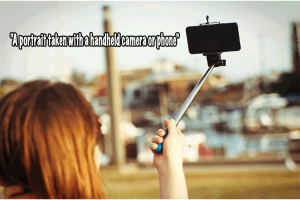 ENGL 197A.401, The Selfie, 5/11/15-6/8/15 (Maymester), M-F from 11:10 a.m.-12:25 p.m., taught by Professor Leisha Jones
ENGL 197A.401, The Selfie, 5/11/15-6/8/15 (Maymester), M-F from 11:10 a.m.-12:25 p.m., taught by Professor Leisha Jones
The selfie, a self-portrait taken with a handheld camera or phone and usually shared over social media, is a contemporary phenomenon with historic roots. Beginning with a history of fine art self-portraiture, this course examines the selfie from a variety of nodes: identity construction and interpellation, authorship, branding, celebrity, data mining, sexuality, dating, and visual digital culture. Students will be required to produce weekly selfie series and papers that interrogate topics under review.
Since the Renaissance, artists have painted and sculpted their own likeness with enough frequency to render it a genre. Self-portraiture remains a common practice among contemporary artists, who use themselves as subject matter to showcase their personal aesthetic, to realize their own likeness for themselves, to place themselves within a lexicon of artworks and other artists, and to use the most convenient and accessible model. From critical obsession with Diego Velázquez’s complicated Las Meninas (1656) to Frida Kahlo’s 55 self-portraits made “(b)ecause I am so often alone…because I am the subject I know best,” the history of art is replete with examples of exquisitely rendered objects that require time and skill to produce. The advent of photography becomes a game changer here, as the technology to faithfully reproduce your own likeness is now available on a mass scale. Photographers such as Cindy Sherman, who reinvented the self-portrait as film still, embody the late 20th century practice of identity production and performance that portends the 21st century explosion of digital self-representation. Today it is not only the artist who is compelled to craft a self but also anyone who participates in social media. We are interpellated to make ourselves into brands and our management of the way we look is a huge part of that. My goal for the course is to get students to think critically about their every day practice of the selfie — not only to recognize the history that informs it but also to interrogate their own productions of the self. Many freshman start college already have taken thousands of selfies but have never asked themselves “What happens when I turn myself into an object?” or “How is it that I produce myself?” In this course we will perform a number of selfie experiments in order to find out.

Now that everyone owns a smartphone, i – Pad, tablet, android or has a Facebook account,
getting an audience to pick up a free to play game is
easier than ever and therefore the chances of being lucrative are increased.
If the gold mines and elixir collectors are of high levels, then you can consider
having them inside walls. With a healthy
presence in a variety of new platforms, from mobile phones to
social games to tablets, Pop – Cap is well-positioned to
tap into a burgeoning sector, Mr.